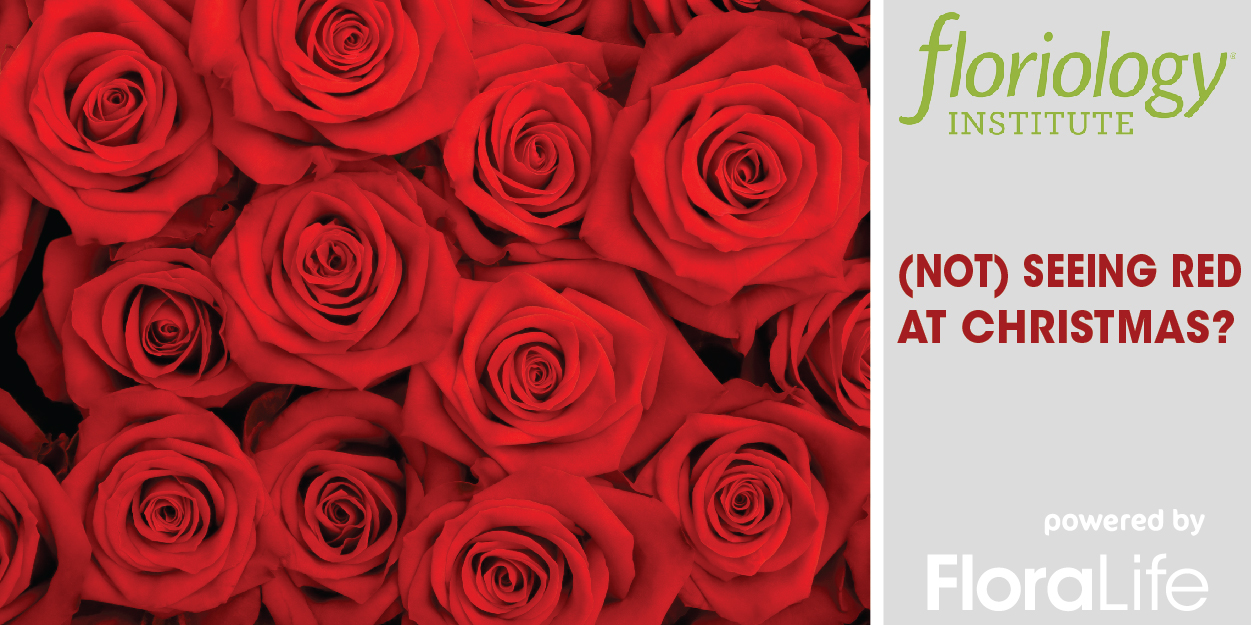(Not) Seeing Red at Christmas?
Floriology Institute December 2021, powered by FloraLife

It is the Christmas season in your flower shop. You have crafted and curated a magical wonderland of holiday merchandising throughout. Everywhere you turn, there is a new yuletide treasure to behold – and to purchase.
But your prospective customer looks vexed. She stands on tiptoe at the display cooler, craning her neck looking past, around, and behind the flowers on display. Finally, with an irritated sigh she says, “I’m just looking for red roses for Christmas. Seems like a simple request!”
You may be tempted to reply, “It is, and the simple answer is that we don’t have them; please choose something else.” If, however, you would like to give a less frustrated, more edifying and value-added answer, please keep reading!
A Matter of Timing
The relative scarcity of red roses at Christmas is a fact of life in floral retail. If there is blame to be assigned, it’s not the fault of poor planning on the part of the retailer, wholesaler, or distributor. It is due to fact that Christmas is a mere seven weeks before biggest rose day of the floral year, February 14th. So, each year, Christmas red roses are victim to an array of market forces set in motion as far back as 1849, when an American magazine quipped, “this ‘Saint Valentine’s Day’ is becoming, nay it has become, a national holy day.” (Note that Christmas wasn’t an official US holiday until 1870!)
The Economy of Biology
In the giant machine that is global rose production, Valentine’s Day is the flywheel that regulates every other process throughout the year. Over 90% of roses sold in the US originate in Colombia and Ecuador, where the growth cycle is 75 to 85 days (cycles differ in other growing regions around the world.) This cycle of growth affects the types and colors of roses available in the US the rest of the year, with the most immediate effects being felt during the Christmas season.
To meet the demands of February 14th – a date that never changes – shipments of red (and also white and pink) roses from their South American origins to their North American destinations must begin at the end of January. So, the growing cycle must commence roughly 80 days prior to that.
Destruction and Rebirth: The Circle of (Floral) Life
It is a cycle, like many in agriculture, which begins with destruction. At the end of cycle that precedes Valentine’s Day shipping, growers carefully prune away the stems. This elimination causes new buds to push at the base so that healthy new stems can form. In fact, one pruned stem can clear the way for up to 2.5 fresh ones, on average.
However, with red roses as a primary desired outcome for February 14th, this means that a huge percentage of red-bearing plants are pruned and out of commission from mid-November onward.
So, why don’t they simply adjust the production schedule, grow more red roses, and prune them in, say, late September for Christmas delivery? As the captain of the Titanic might have explained, a course correction isn’t easy for a boat this big!
As it stands, this massive rose-growing effort is designed to meet the typical demand for Valentine’s Day, allow for excess demand, and also attempt to allow to the normal disruptions in growing conditions such as rainfall, temperature, and sunlight. Basically, the Valentine Vortex pulls in the available production resources from every direction.
Economies of Scale
As for demand, the biggest floral powers set the tone, just like any other business. Large supermarket chains have contracts with growers that clearly spell out the massive volume of roses they will buy and what they will pay during the Valentine’s Day season. These terms and conditions are set a year or more in advance. Meanwhile, wholesalers typically have standing orders with growers or bouquet operations, where they also commit to taking a certain volume of flowers each year. They also agree upon the amount of extra volume they can purchase and the price. The idea is to create a sense of price and supply stability in the market. And those who fail to plan may find themselves in a panic-buying situation where they are charged whatever the market will bear – IF they can find any extra product on the market.
What will the market bear this year? Understandably, growers are interested in finding out, not to take advantage of market conditions, but merely to survive. They have spent the last 80 profitless days coaxing vast greenhouses of bare, pruned rose bushes into (hopefully) profitable fruition. And soon, they must hire an army of workers – double, triple and even quadruple their typical payroll – to harvest, grade, and pack the stems. They must use extra warehouse space, extra trucks, and even chartered airplanes if necessary to get a highly perishable item to market in time. After all of this effort and expense, it is understandable that they might wish to balance supply and demand to achieve the best return.
So, the next time a Holiday customer speaks out of frustration at your lack of red roses for Christmas, take the time to not merely commiserate nor shift the blame elsewhere in the flower chain. Take time to add a little value and truly educate the customer about a little-known facet of this business of ours.
To learn about flower care or to inquire about products and availability in your region, visit www.floralife.com or contact your local FloraLife representative.
